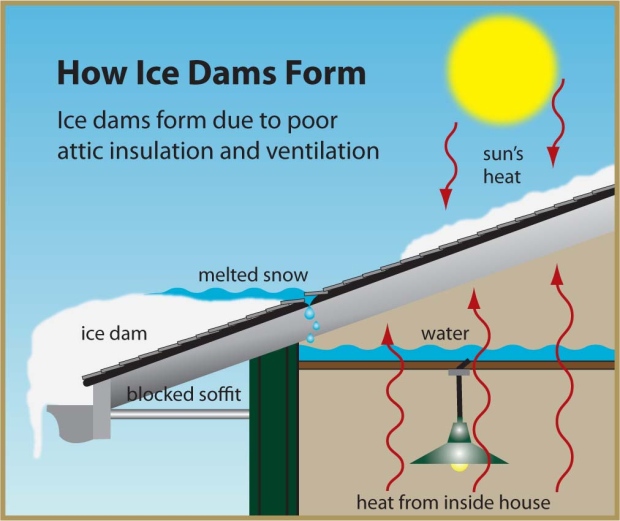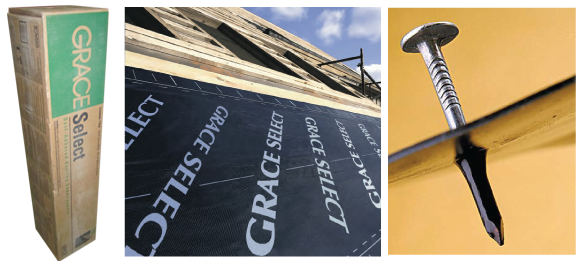Ice Dams: What did I do to deserve this?!?!?!
If you live in the Great Lakes region of the country, I’m sure you’ve experienced this. Heavy snow falls when the temps are nearest to freezing. It thaws again when the temps are above 32 degrees, or the sun starts shining again.
In a cycle of freeze and thaw, often the snow melts off the roof before anywhere else around your home. The eaves (overhang areas where the gutters are) of the home are colder that the rest of the roof. The snow and ice stays here longer, and sometimes that creates a dam that backs water up under the shingles. When that happens, it finds its way into the home causing damage to wood and drywall.
How do I reduce the chance of ice dams forming?
There are two major factors contributing to ice dams you can eliminate. One is through insulation. The heat from your home escaping through the attic space melts the snow within the home’s footprint. The eaves stay colder, so keeping the heat IN the home and not escaping through the attic, will minimize heat build up in the attic. Attic insulation is CHEAP compared to anything else you can do for energy efficiency. Contact us for a quote on insulation. You might be surprised how much bad insulation affects your heating bill. Up to 40% of your energy loss could come from the attic.
The other factor you can control is attic ventilation. In cold climates, the primary reason to vent your attic is to eliminate ice dams, by getting the attic as close as possible to the outside temperature.. It also has the secondary effect of eliminating humidity from the attic. Humidity deteriorates wood framing and decking, as well as the shingles of the roof. Humidity reduces the effectiveness of the insulation, compounding the heat loss factor of ice damming . The National Roofing Contractors Association recommends one square foot of net free intake and exhaust ventilation (each) for every 300 square feet of attic footprint. You can call us for a consultation on attic ventilation, to determine what steps could be used to improve your vent system.
How to protect your home from ice dams:
In some cases, you can’t totally prevent ice dams. That’s the bad news. Mother Nature can hit you with a combination of the freeze-thaw cycles and deep snow no matter what you do. The next step is to prevent the water intrusion when ice damming does occur.
The way we do this is through proper installation of a waterproof underlayment called “ice and water shield.”
Ice and water shield is an underlayment product that goes beneath the roof materials at the eaves, valleys, and penetrations of a roof system. As shown above, it stretches and heals itself around nails to make a near perfect seal. When water backs up behind an ice dam, it leaks through the shingles, but lands on the ice and water shield where it is carried harmlessly out to the gutters.
How much do I need?
Most roofers extend the membrane three feet up from the eave edge of the roof. Some offer a second width to go to six feet. The most important thing to do is extend the ice and water shield at least 24″ past the warm interior wall line of the home. That means your roofer has to factor in the depth of the eave overhang and the steepness of the roof pitch. Did your roofer do the math for you, or did he take a guess? Maybe he didn’t even guess at all.
Ice dams are a fact of life in our area of the country. They cause thousands of dollars in damage when they push water into your home. It just proves the saying, “If you think it’s expensive to hire a professional, just wait until you hire an amateur.” You could be smarter than that, though. We’ll be happy to walk you through the calculations and make sure you’re getting the best SYSTEMATIC approach to roofing, siding, windows, or other upgrades to your home. Check us out and give us a call.
Recent Posts
A primer on windows. What should you buy, and how much of a difference will it make?
The most common questions we get asked here at Hollingsworth Home Improvement regarding new windows are, “What kind of windows should I buy?” and “How much of a difference will new windows make for my home?” The answer to those questions are best answered by a...
What you need to know about re-siding your home
As you walk around your home, you’ve noticed your siding is starting to look too shabby to ignore. Before the neighbors start talking, you decide to call a few siding contractors and get estimates to re-side the home. Your goal is to get at least three bids, compare...
Attic Ventilation: What you need to know, and what your contractor should too!
Roof ventilation is one of the most important aspects to consider in any roofing or siding project. Poor ventilation can cause your shingles to deteriorate faster, lowering the value of your home and the investment you make when hiring a remodeling contractor. Humid...


